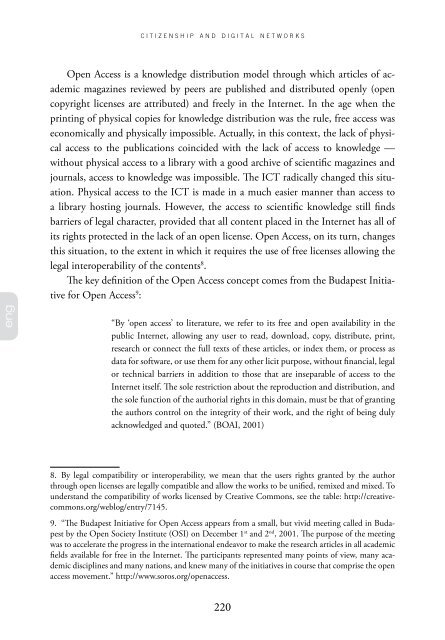Sergio Amadeu da Silveira - Cidadania e Redes Digitais
Sergio Amadeu da Silveira - Cidadania e Redes Digitais
Sergio Amadeu da Silveira - Cidadania e Redes Digitais
You also want an ePaper? Increase the reach of your titles
YUMPU automatically turns print PDFs into web optimized ePapers that Google loves.
eng<br />
c i t i z e n s h i p a n d d i g i t a l n e t w o r k s<br />
Open Access is a knowledge distribution model through which articles of academic<br />
magazines reviewed by peers are published and distributed openly (open<br />
copyright licenses are attributed) and freely in the Internet. In the age when the<br />
printing of physical copies for knowledge distribution was the rule, free access was<br />
economically and physically impossible. Actually, in this context, the lack of physical<br />
access to the publications coincided with the lack of access to knowledge —<br />
without physical access to a library with a good archive of scientific magazines and<br />
journals, access to knowledge was impossible. The ICT radically changed this situation.<br />
Physical access to the ICT is made in a much easier manner than access to<br />
a library hosting journals. However, the access to scientific knowledge still finds<br />
barriers of legal character, provided that all content placed in the Internet has all of<br />
its rights protected in the lack of an open license. Open Access, on its turn, changes<br />
this situation, to the extent in which it requires the use of free licenses allowing the<br />
legal interoperability of the contents 8 .<br />
The key definition of the Open Access concept comes from the Bu<strong>da</strong>pest Initiative<br />
for Open Access 9 :<br />
“By ‘open access’ to literature, we refer to its free and open availability in the<br />
public Internet, allowing any user to read, download, copy, distribute, print,<br />
research or connect the full texts of these articles, or index them, or process as<br />
<strong>da</strong>ta for software, or use them for any other licit purpose, without financial, legal<br />
or technical barriers in addition to those that are inseparable of access to the<br />
Internet itself. The sole restriction about the reproduction and distribution, and<br />
the sole function of the authorial rights in this domain, must be that of granting<br />
the authors control on the integrity of their work, and the right of being duly<br />
acknowledged and quoted.” (BOAI, 2001)<br />
8. By legal compatibility or interoperability, we mean that the users rights granted by the author<br />
through open licenses are legally compatible and allow the works to be unified, remixed and mixed. To<br />
understand the compatibility of works licensed by Creative Commons, see the table: http://creativecommons.org/weblog/entry/7145.<br />
9. “The Bu<strong>da</strong>pest Initiative for Open Access appears from a small, but vivid meeting called in Bu<strong>da</strong>pest<br />
by the Open Society Institute (OSI) on December 1 st and 2 nd , 2001. The purpose of the meeting<br />
was to accelerate the progress in the international endeavor to make the research articles in all academic<br />
fields available for free in the Internet. The participants represented many points of view, many academic<br />
disciplines and many nations, and knew many of the initiatives in course that comprise the open<br />
access movement.” http://www.soros.org/openaccess.<br />
220


